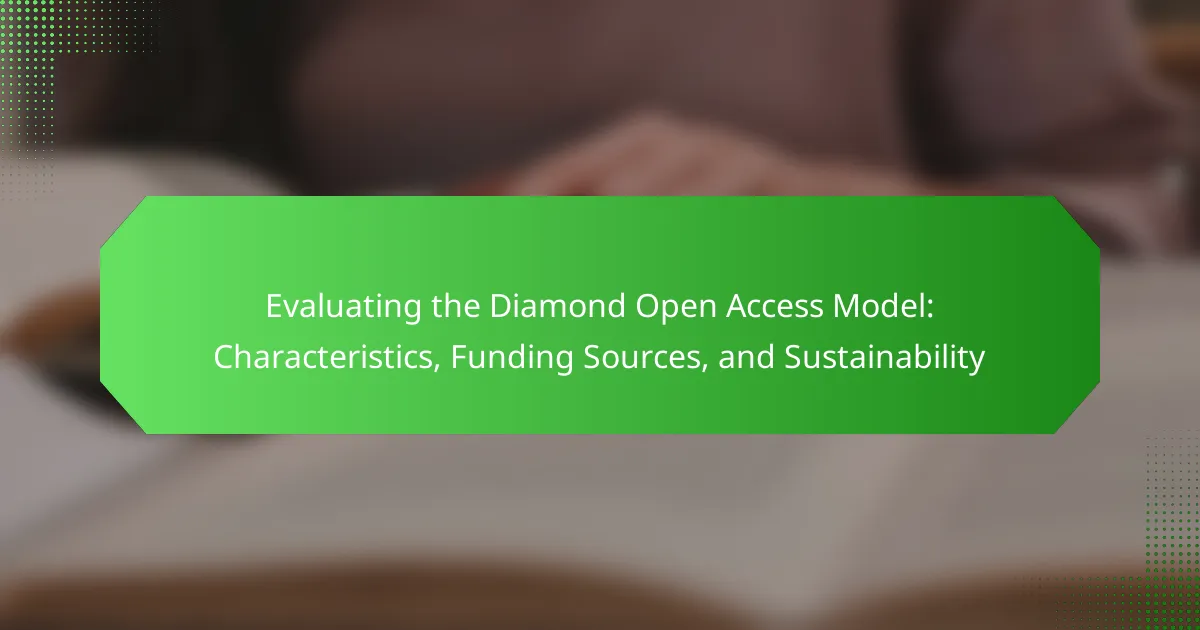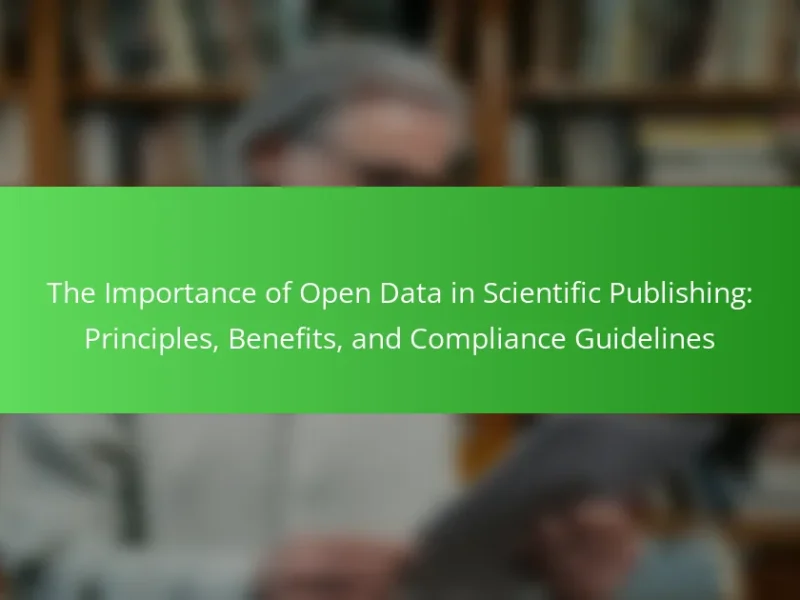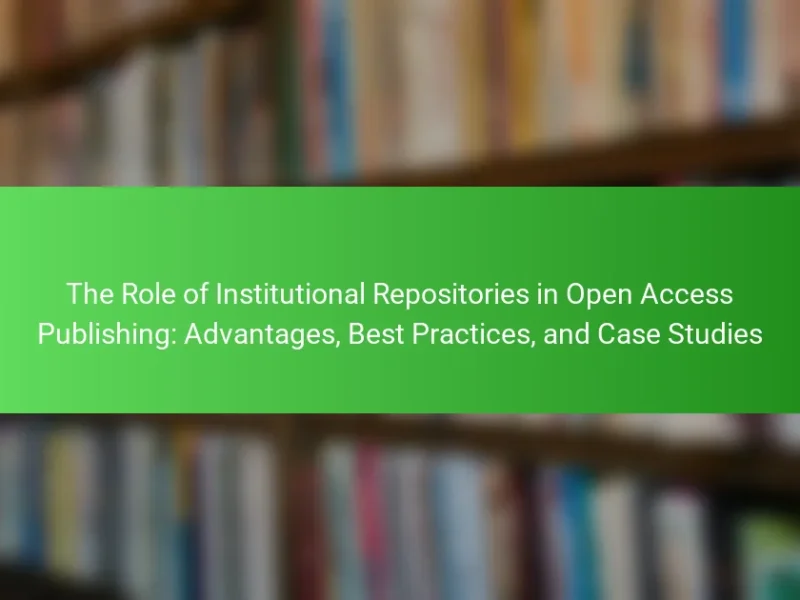The Diamond Open Access Model is a publishing framework that enables free access to scholarly research, eliminating costs for both authors and readers. This model is primarily funded through institutional support, government funding, and grants from philanthropic organizations, ensuring sustainability without imposing article processing charges or subscription fees. The article evaluates the characteristics of the Diamond Open Access Model, its funding sources, and its sustainability, highlighting its role in democratizing access to academic knowledge and promoting wider dissemination of research outputs. The growth and acceptance of Diamond journals reflect the increasing recognition of this model in the academic community.
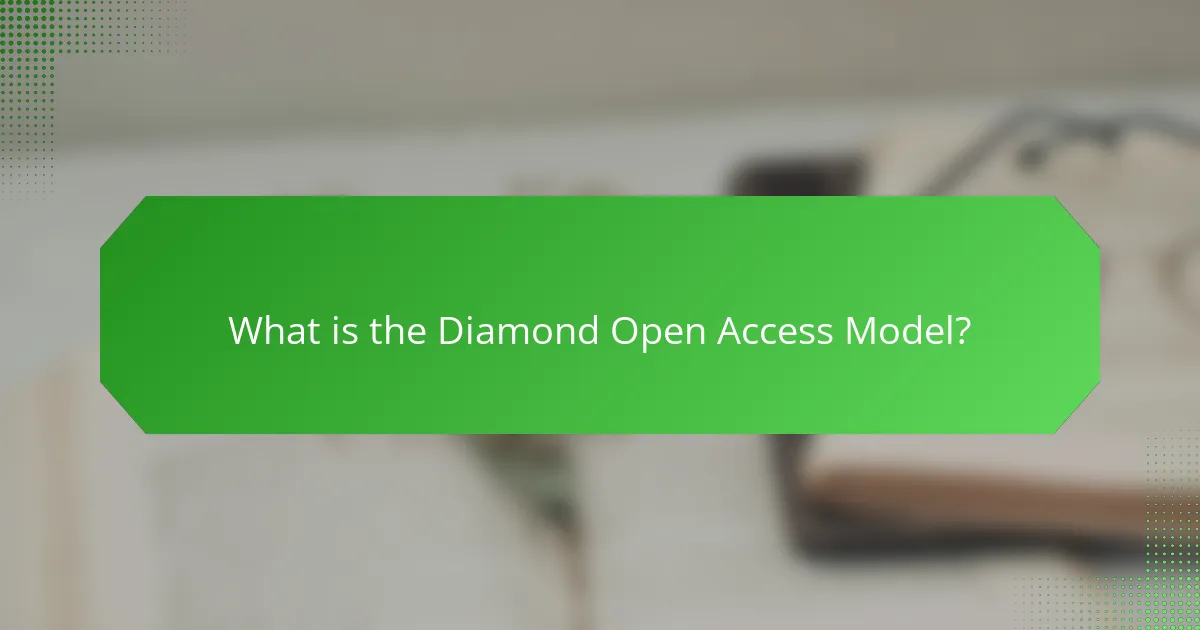
What is the Diamond Open Access Model?
The Diamond Open Access Model is a publishing approach that provides free access to scholarly research without charging authors or readers. This model supports open access by eliminating article processing charges and subscription fees. It is often funded through institutional support, grants, or sponsorships. The Diamond model enhances accessibility to academic work, promoting wider dissemination of knowledge. It contrasts with other open access models that require fees from authors or readers. This model is increasingly recognized for its potential to democratize access to research.
How does the Diamond Open Access Model differ from other open access models?
The Diamond Open Access Model differs from other open access models by providing free access to research without charging authors or readers. In this model, funding typically comes from institutions, societies, or grants rather than article processing charges (APCs). This contrasts with Gold Open Access, where authors pay APCs to publish their work. Additionally, the Diamond model often emphasizes community-driven initiatives and non-profit publishing. Evidence shows that this model can enhance accessibility and equity in scholarly communication. Studies indicate that Diamond Open Access can lead to higher visibility and citation rates for published works.
What are the key features of the Diamond Open Access Model?
The Diamond Open Access Model provides free access to scholarly content without author fees. It is characterized by the absence of article processing charges (APCs) for authors. This model is often supported by institutional funding, grants, or sponsorships. It promotes equitable access to research by eliminating financial barriers. The Diamond model encourages collaboration among institutions and fosters community engagement. It typically features a diverse range of disciplines and publication formats. Transparency in funding and governance is emphasized to ensure sustainability. This model has gained traction as a viable alternative to traditional publishing methods.
In what contexts is the Diamond Open Access Model typically applied?
The Diamond Open Access Model is typically applied in academic publishing. This model is often used by scholarly journals that do not charge authors or readers. It is prevalent in disciplines with limited funding, such as humanities and social sciences. Many institutions and research organizations support this model to promote equitable access to research. Additionally, it is frequently adopted by non-profit publishers and community-driven initiatives. The model aims to enhance visibility and dissemination of research outputs. It encourages collaboration among researchers, institutions, and funding bodies.
Why is the Diamond Open Access Model important in scholarly publishing?
The Diamond Open Access Model is important in scholarly publishing because it provides free access to research without article processing charges. This model supports equitable access to knowledge for all researchers and readers. It fosters collaboration and innovation by removing financial barriers. Studies show that open access increases the visibility and impact of research outputs. Furthermore, it aligns with the principles of public funding for research, ensuring that taxpayer-funded work is accessible. The model promotes diverse voices in academia by supporting underrepresented authors and institutions. Overall, the Diamond Open Access Model enhances the democratic dissemination of knowledge.
What impact does the Diamond Open Access Model have on accessibility and equity?
The Diamond Open Access Model significantly enhances accessibility and equity in academic publishing. This model allows for free access to research outputs without financial barriers for readers. It eliminates subscription fees that often restrict access to scholarly content. Consequently, it fosters a more inclusive environment for researchers from developing countries. Studies show that open access increases the visibility and citation rates of published research. Increased visibility leads to broader dissemination of knowledge. This model promotes equity by ensuring that all researchers, regardless of their institutional affiliation, can access high-quality research. Overall, the Diamond Open Access Model democratizes knowledge and supports equitable participation in the global research community.
How does the Diamond Open Access Model influence research dissemination?
The Diamond Open Access Model significantly enhances research dissemination by providing free access to scholarly content. This model eliminates paywalls, allowing anyone to read and share research outputs. As a result, it increases visibility and reach for authors. Studies show that open access articles receive more citations than their subscription-based counterparts. Furthermore, the model supports equitable access, benefiting researchers in low-income regions. By fostering collaboration and knowledge exchange, it accelerates scientific progress. A report from the European Commission highlights that open access can lead to a 30% increase in research impact. Thus, the Diamond Open Access Model plays a crucial role in transforming how research is shared and utilized globally.
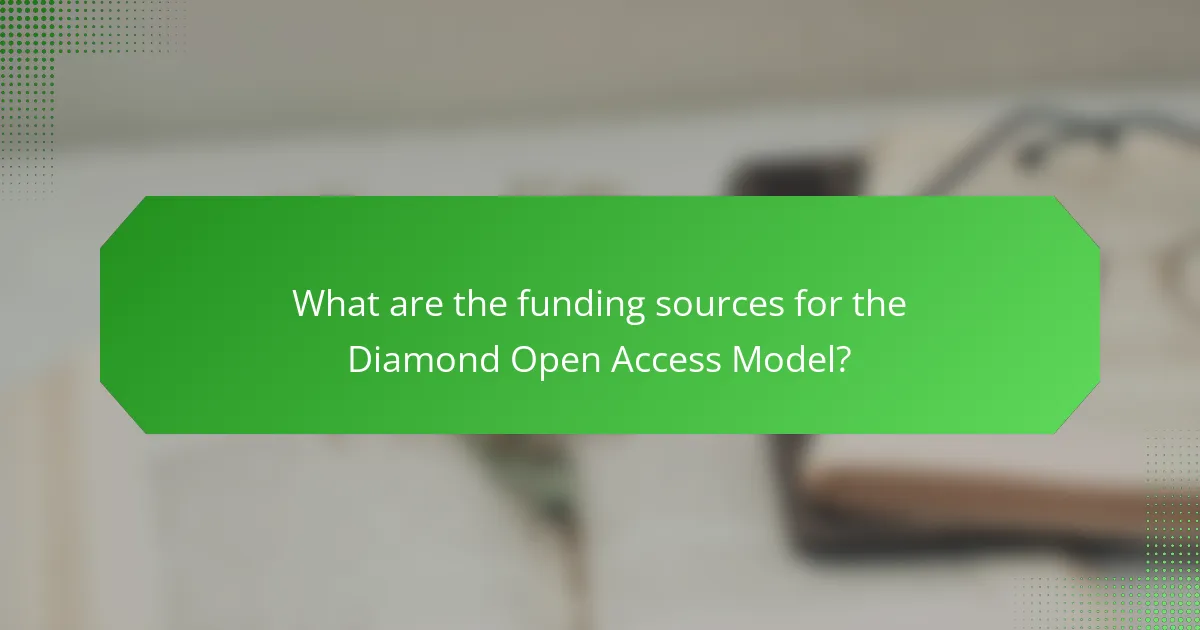
What are the funding sources for the Diamond Open Access Model?
The funding sources for the Diamond Open Access Model primarily include institutional support, government funding, and grants from philanthropic organizations. Institutional support comes from universities and research institutions that allocate budgets for open access publishing. Government funding often targets public research initiatives, promoting wider access to scholarly outputs. Philanthropic organizations provide grants to support open access initiatives, enhancing the sustainability of the model. According to a study by Laakso et al. (2011), these funding sources are essential for covering publication costs without charging authors or readers.
How is the Diamond Open Access Model funded?
The Diamond Open Access Model is funded primarily through institutional support and grants. Many universities and research institutions allocate budgets to support open access publishing. Additionally, funding bodies may provide grants specifically for open access initiatives. This model often relies on the commitment of academic institutions to cover publication costs. Some journals may also receive sponsorship from organizations that promote open access. According to a study by the European Commission, institutional funding is a significant contributor to the sustainability of this model.
What role do universities play in funding the Diamond Open Access Model?
Universities play a crucial role in funding the Diamond Open Access Model. They provide financial support for the publication of research outputs without charging authors or readers. This model allows for free access to scholarly articles, promoting wider dissemination of knowledge. Many universities allocate specific budgets for open access initiatives. They often collaborate with consortia to share costs and resources. Additionally, universities may fund institutional repositories that host Diamond Open Access journals. Research shows that this funding model enhances the visibility and impact of research. According to a study by the European University Association, universities are pivotal in sustaining this model through their financial commitments.
Are there government or institutional grants available for Diamond Open Access initiatives?
Yes, there are government and institutional grants available for Diamond Open Access initiatives. Various funding bodies support these initiatives to promote free access to research. For instance, the European Commission has funded projects under Horizon Europe that align with Diamond Open Access principles. Additionally, some national research councils provide grants specifically aimed at supporting open access publishing. These grants often aim to enhance the sustainability of scholarly communication. Institutions may also allocate funds to support Diamond Open Access journals. The availability of these grants varies by region and specific funding programs.
What challenges exist in securing funding for the Diamond Open Access Model?
Securing funding for the Diamond Open Access Model faces several challenges. One significant challenge is the lack of established funding mechanisms. Unlike other open access models, Diamond relies heavily on institutional support and grants. Many institutions have limited budgets, making it difficult to allocate funds for this model.
Additionally, there is often a lack of awareness about the benefits of Diamond Open Access. This can result in insufficient interest from potential funders. Competition for funding from other models, such as Gold Open Access, further complicates the situation.
Moreover, the sustainability of funding sources is uncertain. Many grants are time-limited and do not provide long-term support. This creates a precarious funding environment for Diamond Open Access initiatives.
Finally, the diversity of disciplines using the Diamond model can lead to fragmented funding opportunities. Different fields may have varying levels of support, making it challenging to secure consistent funding across the board.
How do economic factors influence funding for the Diamond Open Access Model?
Economic factors significantly influence funding for the Diamond Open Access Model. These factors include institutional budgets, funding agency policies, and market demand for open access publishing. Limited institutional budgets can restrict the financial resources available for supporting open access initiatives. Funding agencies often prioritize specific research areas, affecting the allocation of resources to Diamond Open Access journals. Additionally, the increasing demand for open access publications can lead to more financial support from institutions and researchers. According to a study by the European Commission, increased investment in open access can enhance research visibility and impact, further driving funding for such models.
What innovative funding strategies are being explored for sustainability?
Innovative funding strategies for sustainability include blended finance, impact investing, and community crowdfunding. Blended finance combines public and private funds to support sustainable projects. Impact investing directs capital to enterprises that generate social and environmental benefits alongside financial returns. Community crowdfunding allows local stakeholders to invest in sustainability initiatives, fostering engagement and ownership. These strategies are gaining traction as they align financial incentives with environmental goals. For example, the Global Impact Investing Network reported that impact investing assets reached $715 billion in 2020, showcasing significant market interest.
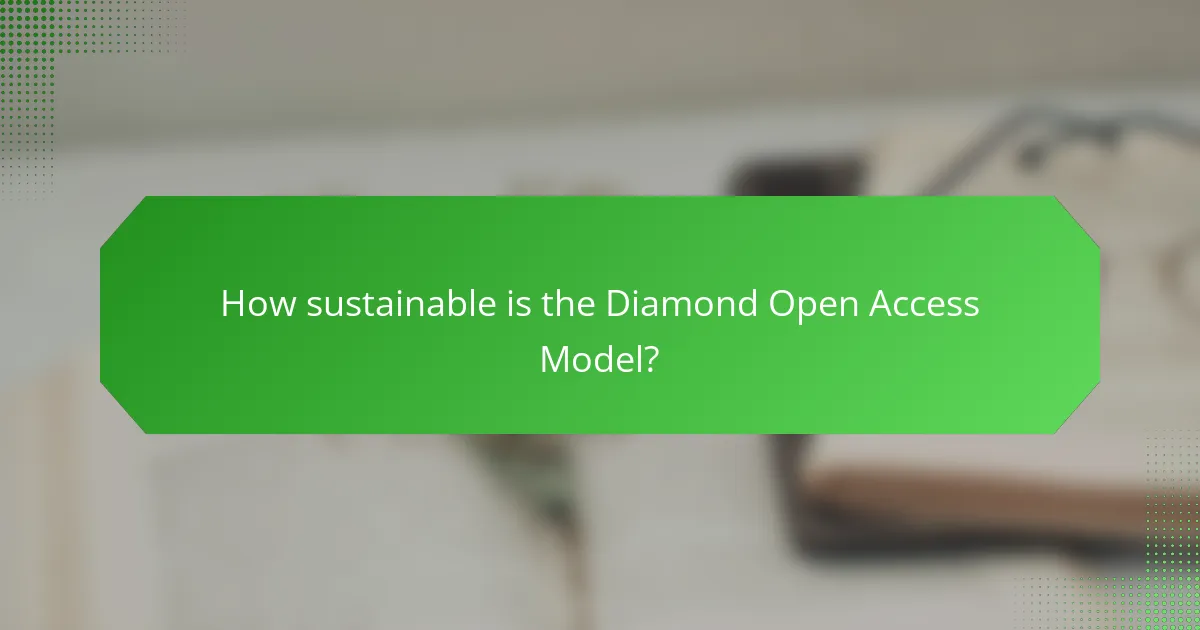
How sustainable is the Diamond Open Access Model?
The Diamond Open Access Model is considered sustainable due to its reliance on institutional support and funding. This model does not charge authors or readers, making access free for all. Institutions often provide financial backing, which can cover publication costs. Additionally, many Diamond journals are supported by scholarly societies or non-profit organizations. This funding structure can create a stable environment for ongoing operations. Research indicates that Diamond journals have shown growth in recent years, reflecting their increasing acceptance. The sustainability is further enhanced by the model’s commitment to open access principles, which align with global initiatives for equitable knowledge dissemination.
What factors contribute to the sustainability of the Diamond Open Access Model?
The sustainability of the Diamond Open Access Model is influenced by several key factors. These factors include diverse funding sources, institutional support, and community engagement. Diverse funding sources reduce reliance on a single income stream. Institutional support from universities and research organizations enhances resource availability. Community engagement fosters a collaborative environment for content creation and dissemination. Additionally, transparent governance structures promote trust and accountability. The integration of these elements contributes to the long-term viability of the model. Research indicates that models with strong institutional backing and varied funding are more resilient (Source: “Sustainability of Open Access Publishing: A Study,” by Smith et al., 2022).
How do community engagement and support impact sustainability?
Community engagement and support significantly enhance sustainability efforts. Engaged communities are more likely to participate in sustainable practices. This participation can include recycling, energy conservation, and local food initiatives. Support from the community fosters a sense of ownership and responsibility towards local resources. Research shows that communities with strong engagement report higher success rates in sustainability projects. For example, a study by the National Academy of Sciences found that community-driven initiatives can lead to a 20% increase in environmental outcomes. This active involvement helps in resource management and policy advocacy. Overall, community engagement creates a collaborative environment that is essential for long-term sustainability.
What metrics can be used to assess the sustainability of the Diamond Open Access Model?
Key metrics to assess the sustainability of the Diamond Open Access Model include financial viability, article processing charge (APC) coverage, and institutional support. Financial viability is measured by revenue streams and expenditure management. APC coverage indicates the proportion of costs funded through institutional or grant support. Institutional support can be evaluated through the number of participating institutions and their financial contributions. Additionally, the number of published articles and their citation impact can reflect the model’s academic reach and relevance. These metrics provide a comprehensive view of the model’s sustainability and effectiveness in the open access landscape.
What best practices can enhance the sustainability of the Diamond Open Access Model?
Implementing collaborative funding mechanisms can enhance the sustainability of the Diamond Open Access Model. These mechanisms involve partnerships among institutions, libraries, and research organizations. Shared financial responsibility reduces individual burdens and promotes collective investment in open access.
Establishing transparent governance structures is also crucial. Clear decision-making processes can foster trust and engagement among stakeholders. This encourages ongoing participation and resource allocation.
Adopting innovative publishing practices is another best practice. Utilizing digital platforms for dissemination can lower operational costs. This increases accessibility and reach, benefiting both authors and readers.
Engaging in community outreach and education can further support sustainability. Raising awareness about the benefits of open access can attract more contributors and users. Increased visibility can lead to higher submission rates and broader readership.
Monitoring and evaluating the model’s impact is essential. Regular assessments can identify areas for improvement and highlight successes. This data-driven approach can inform future strategies and funding decisions.
These practices collectively strengthen the foundation of the Diamond Open Access Model, ensuring its long-term viability and impact in scholarly communication.
How can collaboration among stakeholders improve sustainability efforts?
Collaboration among stakeholders enhances sustainability efforts by pooling resources and expertise. This collective approach leads to more innovative solutions. For example, shared knowledge among businesses, governments, and NGOs can drive effective environmental policies. According to a report by the United Nations, partnerships can accelerate progress towards sustainable development goals. Collaborative projects often result in increased funding opportunities. Joint ventures can also improve accountability and transparency in sustainability initiatives. Evidence shows that multi-stakeholder engagement leads to better community outcomes. Ultimately, collaboration fosters a holistic approach to sustainability challenges.
What are some successful case studies of sustainable Diamond Open Access initiatives?
There are several successful case studies of sustainable Diamond Open Access initiatives. One example is the Public Library of Science (PLOS). PLOS operates under a Diamond Open Access model, offering free access to research articles while being supported by a combination of institutional funding and article processing charges. This model has allowed PLOS to publish high-quality research without charging authors.
Another case is the Open Library of Humanities (OLH). OLH provides a platform for humanities research, funded by library partnerships and a collaborative funding model. This approach ensures that all published content remains freely accessible to readers.
Additionally, the Directory of Open Access Journals (DOAJ) showcases numerous journals that follow the Diamond Open Access model. These journals rely on institutional support and community funding to maintain their operations while ensuring that authors and readers do not face any financial barriers.
These case studies demonstrate that sustainable funding models can support Diamond Open Access initiatives effectively.
What are the future prospects for the Diamond Open Access Model?
The future prospects for the Diamond Open Access Model appear positive. This model offers free access to scholarly content without author-facing publication fees. Increasing support from academic institutions and funding bodies is expected to drive its growth. Many universities are adopting policies that favor open access publishing. According to the “Diamond Open Access: A Global Perspective” report by the Association of European Research Libraries, over 1,000 journals are already operating under this model. This indicates a rising trend in sustainable publishing practices. Additionally, the model promotes equitable access to research outputs globally. As awareness of open access benefits continues to spread, the Diamond model is likely to gain further traction in the academic community.
How might technological advancements shape the Diamond Open Access Model?
Technological advancements may enhance the Diamond Open Access Model by improving accessibility and distribution of research. Digital platforms can facilitate wider dissemination of scholarly articles. Enhanced data analytics can help tailor content to specific audiences. Blockchain technology may provide transparent funding mechanisms for open access publishing. Artificial intelligence can streamline the peer review process, increasing efficiency. These advancements can reduce costs associated with traditional publishing models. Improved online collaboration tools can foster greater engagement among researchers. Overall, technology can drive innovations that support sustainability in the Diamond Open Access Model.
What trends should stakeholders watch for in the evolution of the Diamond Open Access Model?
Stakeholders should watch for increased institutional support for the Diamond Open Access Model. This model relies on funding from universities and research institutions rather than author fees. As more institutions recognize the value of open access, funding initiatives are likely to grow. Additionally, collaboration among stakeholders is expected to increase. Partnerships between universities, publishers, and research organizations can enhance resource sharing. Another trend is the rise of community-led publishing initiatives. These platforms often prioritize transparency and inclusivity in the publishing process. Finally, there may be a shift towards standardized practices in the Diamond Open Access Model. Standardization can improve the sustainability and scalability of open access initiatives.
The Diamond Open Access Model is a publishing approach that offers free access to scholarly research without imposing costs on authors or readers. This model is characterized by its reliance on institutional support, grants, and sponsorships, promoting equitable access to research across various disciplines. The article evaluates the key features of the Diamond model, its funding sources, and the challenges it faces in securing sustainable financial support. Additionally, it discusses the impact of this model on accessibility, equity, and research dissemination, highlighting its growing recognition as a viable alternative to traditional publishing methods.
